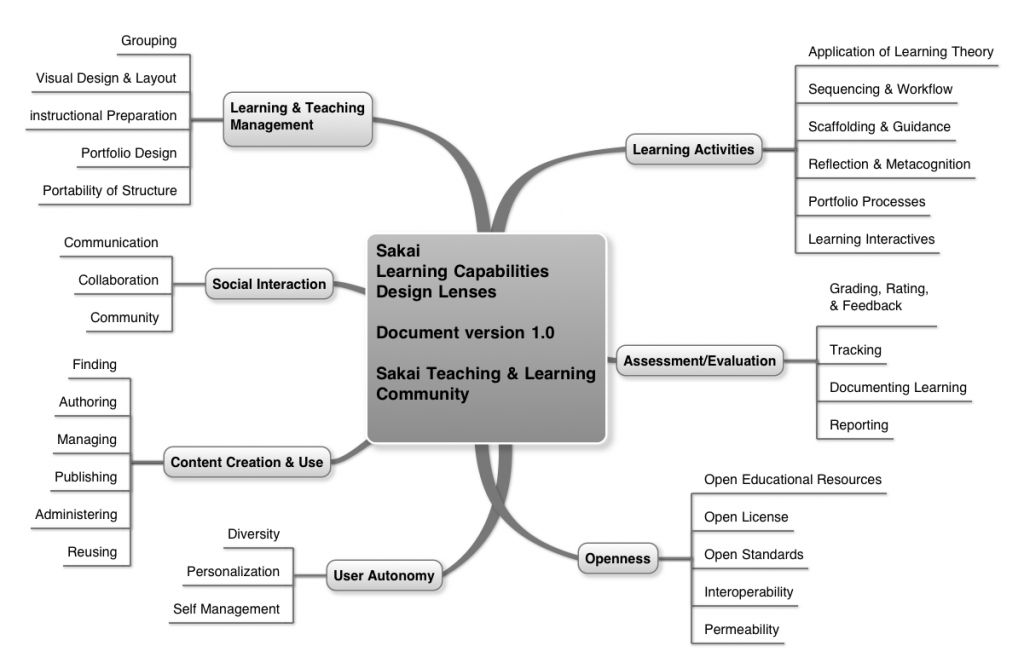Here it is! All about the past, present, and future of Moodle:
It’s interesting to compare Moodle’s trajectory with Sakai’s. On the one hand, there’s evidence that the Moodle and Sakai communities are moving toward each other in terms of vision. The design principles that Martin describes as having guided Moodle development from the beginning are similar in approach and overlapping in content with the “lenses” that the Sakai community is adopting to guide Sakai 3 design:

At the same time, the description that Martin gives of his early thinking about the design goals for Moodle 3, as well as its relationship to current-generation learning management, is quite similar to the path that the Sakai community has taken with Sakai 3, particularly vis-a-vis Sakai 2.
On the other hand, the Moodle and Sakai sustainability and governance models are quite different from each other and show no signs of converging. Moodle’s model puts a company with a strong central manager in charge of most core development. Money flows from adopting schools, through Moodle support partners, and into Moodle Pty., under Martin’s direction, to pay for the core developers. Sakai, in contrast, works on a consortial model with a foundation at its center. Both approaches have pros and cons, but the point is that they are quite different and have different risks for adopting schools to manage. We tend to talk about the choice between private source and open source as if the latter were monolithic, but actually there’s huge variety in the ways that these projects work. You have to evaluate the strengths and risks associated with each open source support ecosystem individually, just as you would evaluate the strengths and risks associated with each private source vendor individually.
Anyway, many thanks to Martin for an illuminating discussion.
There was an interesting talk at the 2010 UK Moodle Moot about different open source governance models, given jointly by Ross Gardler of OSS watch, and Sean Keogh from Pteppic, one of the UK Moodle partners. It talked about the range models available to projects, and where Moodle fitted on the spectrum. The first part, about the range of models, is basically on the OSS watch web site: of http://www.oss-watch.ac.uk/resources/governanceModels.xml, if you want to read more.
As someone who spends a lot of time in the Moodle world, I took away two strong messages form this talk.
1. I had never really thought about Moodle governance in this way, and it was a nasty shock to be told “Moodle is a lot like MySQL.” There is one important difference, however, which is that moodle.com does not require, or even request, assignment of copyright, and no one is trying to make closed-source versions.
2. It does not really matter. If you look at the day-to-day operation of any open source project, you have users and developers forming a community and discussing features. You have developers developing and reviewing each others’ patches. You have decision making mostly by tacit consensus. It is only in the very rare case of irresolvable disagreement that the governance model really matters. You could say that it does not matter until something goes wrong.
I will also add that having watched Martin D operate for the last four or five years, he makes a very good benevolent dictator. He is very good at listening, and getting people to work together. So, even if I think that in general, a more democratic governance model is better, I don’t see any need to change the way the Moodle project runs itself.
Tim, I don’t think one model is inherently better than another. You have to look at each one, figure out where your risk exposure is (as you do in your first realization), and evaluate whether those risks are being mitigated adequately for your purposes (as you do in your second). But risks are specific both to the project and to the adoptee. Some schools will care more about any given risk than others.
As I’m listening to the interview, I’m reminded that I really think Sakai needs a user forum something like Moodle’s: a place where instructors can go to ask about best practice details and such.
… come to think of it, maybe Sakai OAE could provide a unique eat-the-dogfood opportunity towards this end to test just how well the communication and collaboration functionality works out? Put up an instance at sakaiproject.org and use it to facilitate broader community engagement.
There is such a place, Bruce. It’s called the Pedagogy List, it’s reasonably active, and you can subscribe to it at http://collab.sakaiproject.org/mailman/listinfo/pedagogy.
I was thinking of something other than another mailing list. I really need to drop a number of lists that I don’t have time to keep up with; not add another.
Also, a list is really disconnected from the Sakai technology. I’m not the biggest fan of Moodle’s interface, but I think it’s to their great credit that they use their technology as the basis for their community. Why shouldn’t Sakai?
I have raised this issue myself in the past. At this point, I think the biggest problem is that enough of people are using what’s already there that managing the change would become a resourcing issue. It could be done, but it competes against other priorities. It is possible that Sakai 3 will offer an opportunity for a transition, at least for the Sakai 3 project.
Yeah, that’s kind of what I was wondering. I don’t think S2 is very well suited to this anyway. In all seriousness, perhaps this should be a use case for S3?
Good interview, but the face tracking on the video makes me feel a bit seasick!